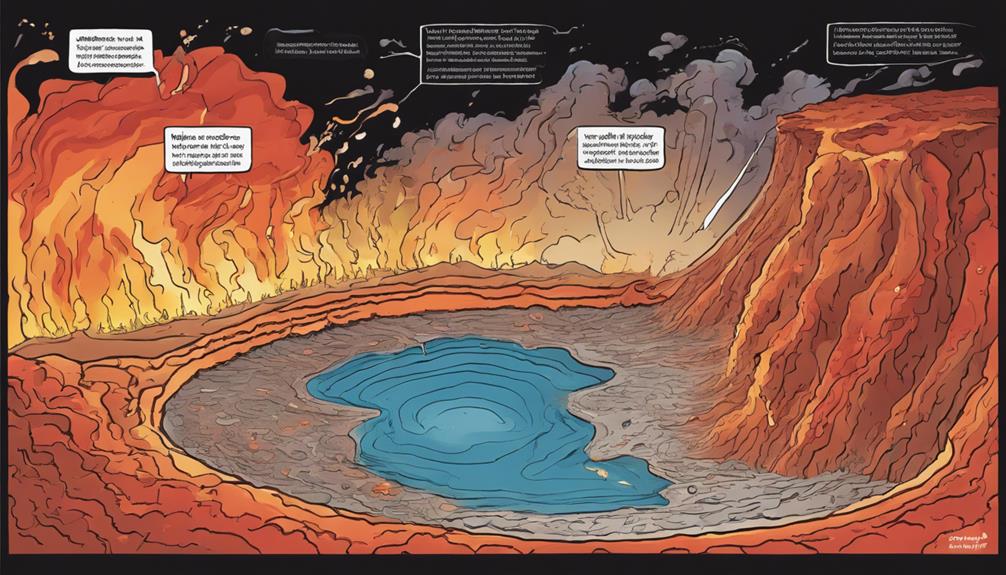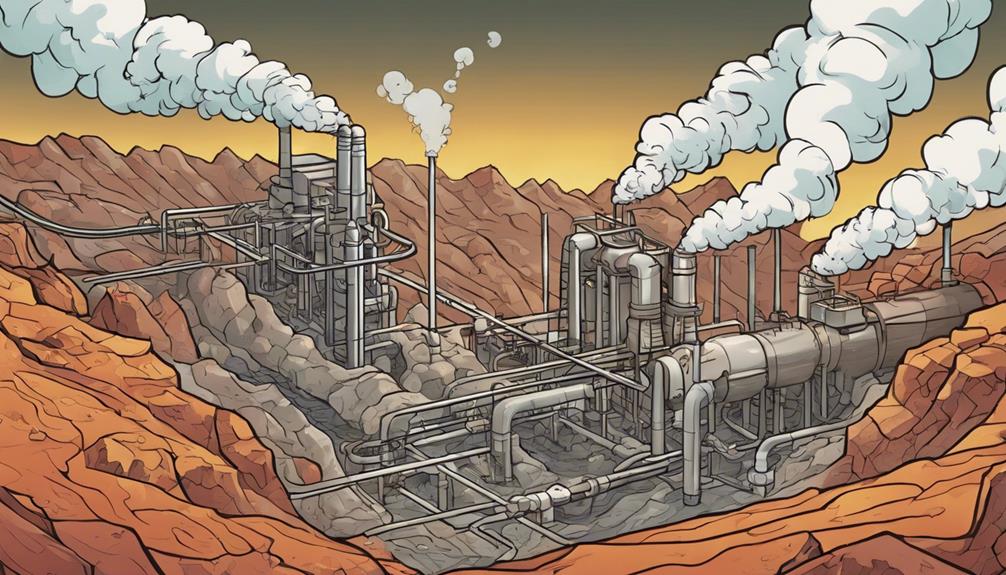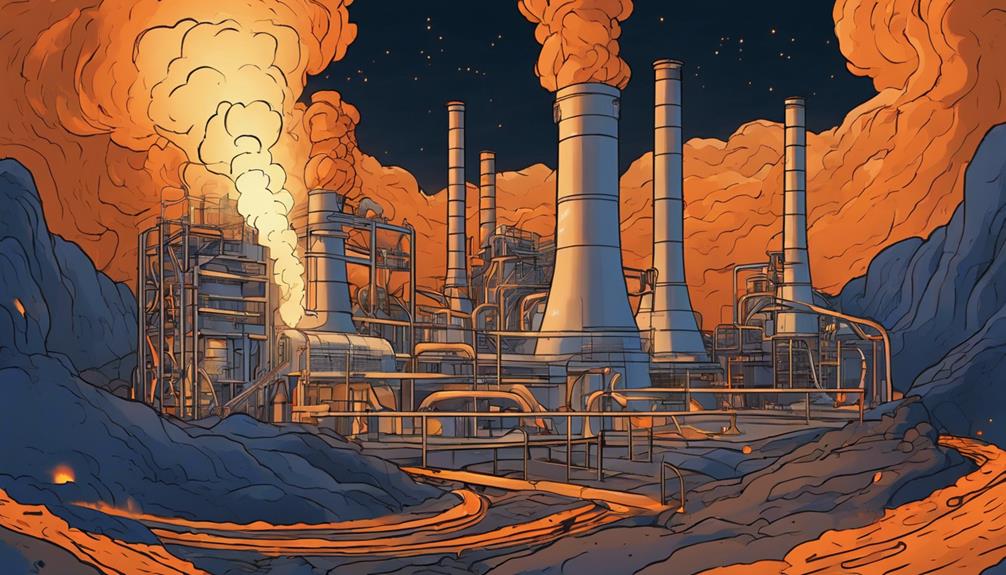As we shift towards a more sustainable future, we're turning to the Earth's internal heat engine, where magma convection is revolutionizing geothermal energy generation by accessing the vast potential of heat from the planet's core. This process facilitates efficient heat transfer, drives the movement of molten rock, and creates circulation of hot fluids. Magma convection is crucial for energy production and has a significant impact on geothermal systems. By harnessing this power, we can reduce our reliance on fossil fuels and guarantee a greener future. Let's explore how this technology is paving the way for a sustainable energy solution.
Key Takeaways
- Magma convection facilitates efficient heat transfer, driving the movement of molten rock and creating circulation of hot fluids for geothermal energy generation.
- Advanced technologies, such as enhanced heat exchangers and optimized reservoir management systems, are being developed to harness magma heat sustainably.
- Magma convection predicts volcanic activity, influences magma chambers, and enables the reliable and sustainable production of geothermal energy.
- By tapping into Earth's internal heat engine, magma convection technologies can reduce reliance on fossil fuels and ensure a greener future.
- Innovations in magma convection are poised to revolutionize geothermal energy generation, providing a constant and renewable energy source.
Importance of Magma Convection

As we delve into the world of geothermal energy production, it becomes increasingly clear that magma convection plays a vital role in facilitating heat transfer, driving the movement of molten rock beneath the Earth's surface and creating the circulation of hot fluids important for geothermal systems.
This process is essential for energy production, as geothermal fluids heated by magma convection are utilized for electricity generation and heating purposes. Magma convection's impact on fluid flow, heat distribution, and reservoir productivity is significant, making it a key factor in harnessing geothermal energy.
Heat Transfer Mechanisms

We're now going to explore the heat transfer mechanisms that make magma convection so effective in geothermal energy production, starting with convection itself as a key driver of heat transfer from the mantle to the crust.
Convection plays a pivotal role in transferring heat through magma movement, driven by density differences. This process allows for the efficient transfer of heat from the Earth's core to the surface, making it possible to harness geothermal energy.
Understanding convection helps predict volcanic activity, influences magma chambers, and optimizes geothermal energy utilization. By grasping these heat transfer mechanisms, we can better tap into the Earth's natural heat, unleashing the full potential of geothermal energy generation.
Challenges in Geothermal Production

Despite its potential, geothermal energy production faces several challenges that hinder its widespread adoption and efficient operation. We encounter high upfront costs, geological uncertainties, and technical issues that make it difficult to tap into this renewable energy source. Additionally, regulatory hurdles and reservoir management complexities add to the list of obstacles.
| Challenge | Impact |
|---|---|
| High upfront costs | Discourages investment |
| Geological uncertainties | Increases exploration risks |
| Technical issues | Reduces plant efficiency |
| Regulatory hurdles | Delays project implementation |
Benefits of Geothermal Energy

Geothermal energy offers a unique combination of reliability, sustainability, and environmental benefits, making it an attractive alternative to fossil fuels. As we shift towards a cleaner energy future, geothermal energy stands out for its ability to provide a constant and reliable energy supply.
We're not just reducing our carbon footprint; we're also creating jobs and stimulating local economies. Plus, geothermal energy is a domestic source of power, reducing our reliance on imported fuels and enhancing energy security. By harnessing the Earth's natural heat, we're paving the way for a more sustainable and resilient energy sector.
As we continue to advance geothermal technology, we're unleashing its full potential to combat climate change and achieve carbon neutrality.
Future of Geothermal Power

As the world shifts to a low-carbon economy, magma convection-driven geothermal power is poised to play a pivotal role in the global energy mix, offering a reliable and constant source of renewable energy.
We're on the cusp of a geothermal revolution, driven by innovations in drilling, exploration, and heat extraction technologies.
As we look to the future, we're excited about the prospects of harnessing magma convection to generate power.
With continued research and development, we can unveil the full potential of geothermal resources, driving the global energy sector towards a more sustainable and resilient future.
We're committed to advancing geothermal energy technology, ensuring a greener and more sustainable tomorrow.
Harnessing Magma Heat

We're tapping into the Earth's internal heat engine, where magma convection transfers intense heat to the surface, promising a game-changing opportunity to generate power from this vast, untapped energy source.
By harnessing magma heat, we can access the potential for sustainable energy production. The key lies in developing technologies that can efficiently transfer heat from the magma to power turbines, despite extreme temperatures and pressures.
Our research focuses on monitoring and understanding magma convection to maintain the high temperatures needed for geothermal power production. As we continue to innovate, we're getting closer to a greener, more sustainable future where magma heat plays a critical role in powering our homes and communities.
Magma Convection Technologies

Developing advanced magma convection technologies is vital to efficiently tap into the Earth's internal heat engine, enabling us to generate power from this vast, untapped energy source. We're working on innovative solutions to harness the heat transferred by magma convection, which is essential for geothermal energy production. Our focus is on creating more efficient heat exchangers, advanced drilling techniques, and enhanced reservoir management systems.
| Technology | Description |
|---|---|
| Enhanced Heat Exchangers | Improve heat transfer efficiency between magma and geothermal fluids |
| Advanced Drilling Techniques | Reduce drilling costs and increase well productivity |
| Reservoir Management Systems | Optimize fluid flow and heat distribution in geothermal reservoirs |
| Magma Monitoring Tools | Track magma movement and temperature to guarantee sustainable energy production |
Sustainable Energy Solutions

By utilizing magma convection technologies, we can access sustainable energy solutions that tap into the Earth's internal heat engine, providing a reliable and constant source of renewable energy.
This innovative approach enables us to harness the Earth's heat, reducing our reliance on fossil fuels and mitigating climate change.
Geothermal energy, powered by magma convection, offers a clean and sustainable alternative for electricity generation and heating.
As we continue to develop and refine these technologies, we can open up the full potential of geothermal energy, ensuring a greener and more sustainable future.
Frequently Asked Questions
How Does Magma Convection Affect Geothermal Energy Storage Capacity?
We're exploring how magma convection impacts geothermal energy storage capacity, and we've found that it substantially affects fluid flow, heat distribution, and reservoir productivity, ultimately influencing the overall storage capacity of geothermal systems.
Can Magma Convection Be Used for Cooling Purposes as Well?
We've been exploring the potential of magma convection for power generation, but can it also be used for cooling purposes? Yes, we believe it can, by leveraging the same heat transfer mechanisms to efficiently cool systems.
What Is the Ideal Depth for Harnessing Magma Convection Energy?
"We're exploring the ideal depth for harnessing magma convection energy, and research suggests it's between 5-10 kilometers, where temperatures are hot enough to generate significant power without excessive pressure or corrosion risks."
How Does Magma Convection Impact Local Ecosystems and Biodiversity?
We examine how magma convection affects local ecosystems, finding it can alter habitats, disrupt species migration, and impact groundwater quality, requiring careful environmental assessments to guarantee sustainable geothermal energy development.
Can Magma Convection Be Used in Conjunction With Other Renewable Energy Sources?
We believe that combining magma convection with other renewables, like solar and wind power, can create a robust and diverse energy mix, enhancing overall energy security and reducing our reliance on fossil fuels.
How Does Magma Convection Impact Inlet and Outlet Systems in Geothermal Energy Generation?
Magma convection plays a crucial role in geothermal energy inlet systems by providing the necessary heat to generate power. The movement of magma beneath the earth’s surface impacts the temperature and pressure of the fluids in the reservoir, affecting the efficiency of geothermal energy inlet systems.
How Does Magma Convection Contribute to Geothermal Energy Generation?
Magma convection plays a crucial role in geothermal power generation technology. As hot magma rises from the Earth’s mantle, it heats underground water reservoirs, creating steam that can be harnessed for energy. This natural process provides a renewable and sustainable source of power for geothermal power generation technology.
Conclusion
As we stand at the threshold of a revolution, we're electrified by the prospect of harnessing Earth's internal furnace.
Magma convection's potent pulse promises a seismic shift in geothermal energy, igniting a future where fossil fuels are a distant memory.
With every breakthrough, we're drawn closer to a world where clean power pulsates through our veins, and a greener tomorrow beckons.
The heat is on – and we're ready to release its fury.










